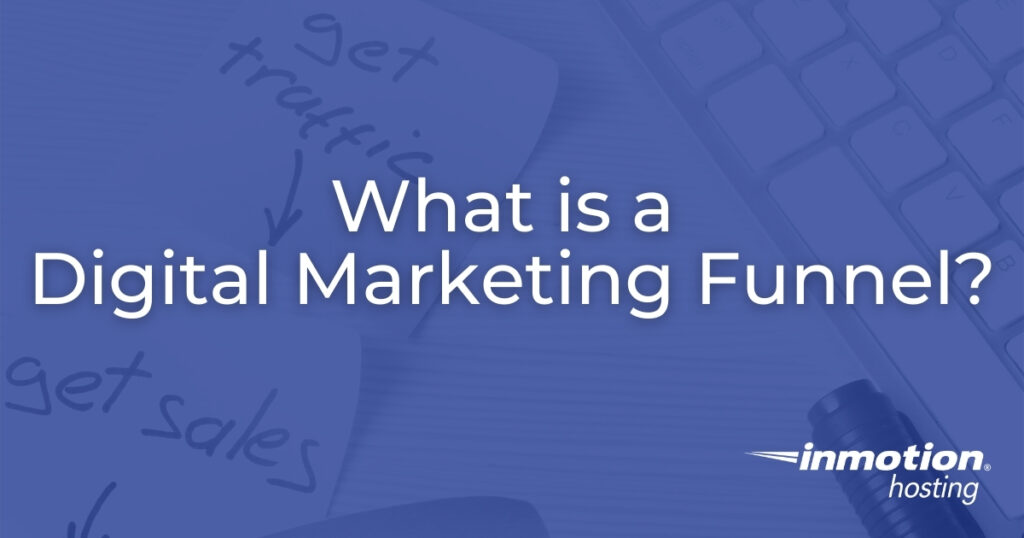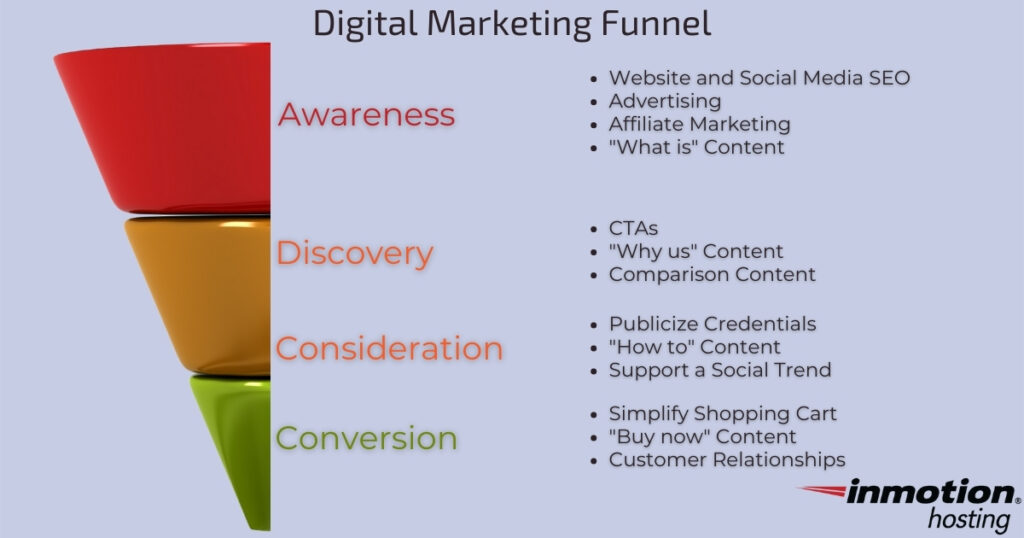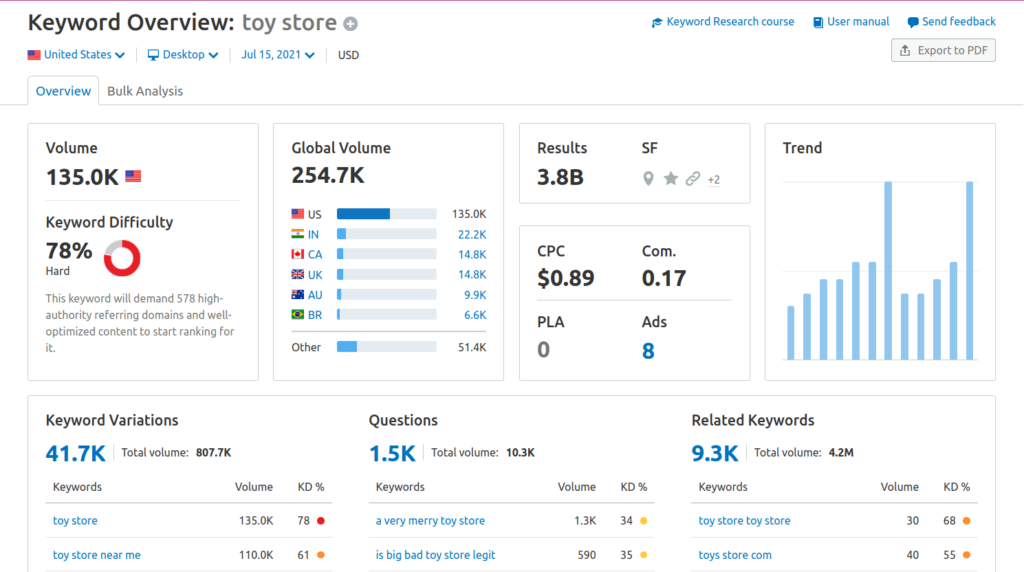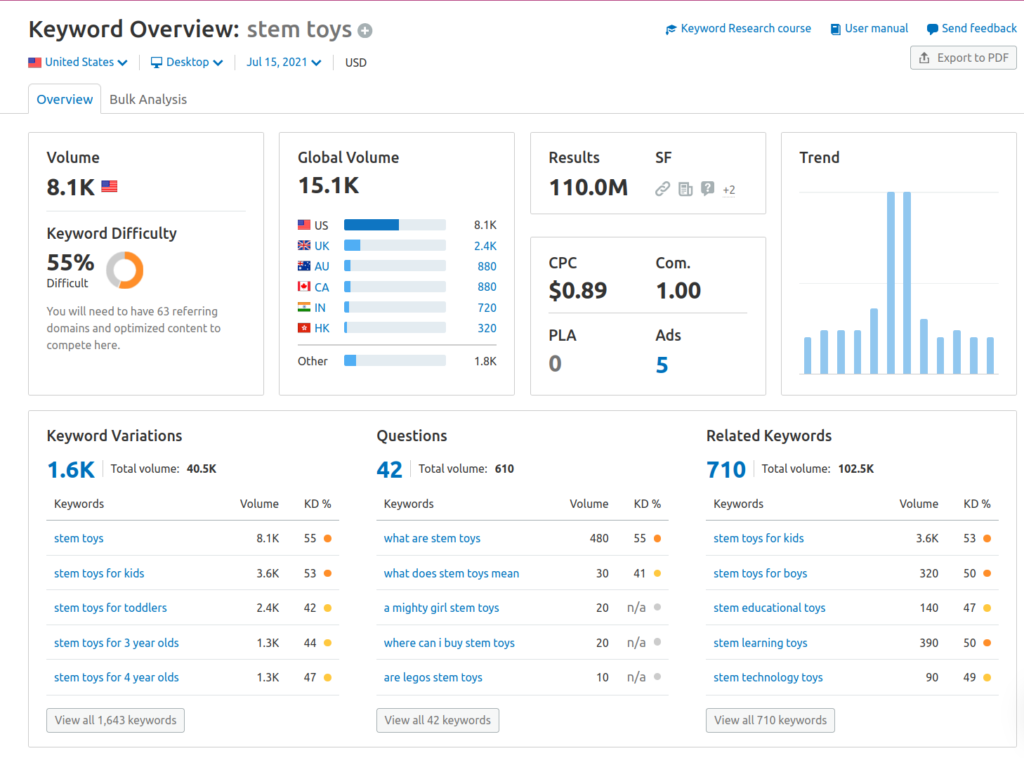
The digital marketing funnel is a modern, online strategy for gaining and retaining clients for your business. The four steps to the digital marketing funnel are:
- Awareness
- Discovery (first part of lead generation)
- Consideration (second part of lead generation)
- Conversion
It is based on the older Awareness, Interest, Desire, Action (AIDA) funnel and general marketing journey: awareness, nurture, convert, and delight. It shares resemblance with other website marketing funnels including:
- Hourglass – a more detailed variation with strong emphasis on customer relationship management, attractive for larger businesses with lots of manpower
- Looping – more agile for small and medium-sized businesses (SMBs), sometimes combined with Avinash Kaushik’s “See-Think-Do-Care” framework
- Micro-moments – quickly answering “I want to know, do, buy, or go ‘X’”
Below we’ll cover more about how to build a digital marketing funnel, complete with examples and common mistakes to avoid.

- Why Is Digital Marketing Funnel Important
- 4 Digital Marketing Funnel Stages
- Customer Relationships and Retention
Why Is Digital Marketing Funnel Important
This is the common journey to making a purchase in today’s world:
- Realize the problem
- Search for a solution
- Compare the best options
- Decide and make a purchase
- Evaluate the purchase and whether to remain with the same brand
This newer digital funnel has a wide range of benefits over the older strategy:
- Considers differing behavior among users
- Focused on learning your needs and preferences
- Helps employees understand the intent of their work and how to best communicate with their targets demographic
- Versatile enough to acknowledge that not everyone starts at the top of the funnel
- You’ll better understand leads’ needs
- Mobile devices and virtual reality (VR) offer innovative ways to advertise
Your Target Consumer Market
Before you develop your digital marketing funnel, you need to figure out your target market:
- Primary demographic region and language
- Experience in related field
- Ethnicity / race
- Marital status
- Sex / gender
- Age group
- Income
- Many more depending on your product
You might need to target different personas for different stages. Example: if you’re making kids toys, the child becomes aware but the parent has to convert (purchase the product).
You may have levels of targets – primary, secondary who may benefit from your products, and others who aren’t looking to purchase but might share your content among their social circle.
Web analytics software tracks how people reach and navigate your website, sign up to email lists, and more. Matomo and Google Analytics are the most popular options and easy to integrate with WordPress and other popular content management systems (CMSs).
4 Digital Marketing Funnel Stages
For each stage, we’ll explain users’ mindset, marketing methods to explore, and content ideas.
Top of Funnel
The awareness phase is considered the top of the funnel (TOFU). Potential customers are aware of the issue, but unsure of the best solution for them. Marketing efforts to reach people at this position should focus primarily on driving traffic to your business with search engine optimization (SEO) and a strong community reputation.
SEO isn’t just about being on the first page for relevant search engine queries. Make it easy for someone to find what they need quickly. This requires research on keywords and keyphrases relevant to your services and industry with tools including:
- Trends.Google.com
- Semrush.com
- Ahrefs.com
- Moz.com
Staying with the toy example, “toy store” and “toys for kids” would be hard to rank for but not something more specific like “STEM toys.”
To improve your chances of being found through organic searches in Google, YouTube, etc., work these SEO keyphrases into your:
- Website metadata (schema and XML sitemap)
- Product landing pages
- Written and video metadata
- Social media activity
- Google Ads campaigns and other search engine marketing (SEM) efforts
Adding your business address and phone number to your contact, about, or quote page can help locals find your business.
Brand reputation spreads by word of mouth. Almost everyone uses online reviews and social media for decision making. To make this more advantageous for you and get the most out of SEO, improve your brand awareness.
Research relevant forums and blogs within your industry. Assign willing team members genuinely interested in them to participate often. Resulting conversations can grant opportunities to educate others about solutions to problems using your products.
Take social media management seriously. It is hard work. That’s why there are dedicated social media manager positions requiring experience with Hootsuite and platform-specific analytics. Being active on social media, and review platforms (for customers and former employees), shows interaction and improves your SEO ranking. Don’t forget the Better Business Bureau (BBB) and TrustPilot pages. And don’t run from negative feedback. Try to decipher constructive criticism to improve your services. This shows you listen to your customers and are changing for the better.
Affiliate marketing pays brand ambassadors to introduce your business (with backlinks) to users who might never realize your existence otherwise. Reputable applications for affiliate programs include Impact.com and Brandbassador.
Sponsoring events and donating to local non-profit organizations build brand awareness and help you build meaningful relationships. It doesn’t have to be money. Time and free assistance go a long way. You can offer internships to local colleges or old equipment you don’t need. It might spark enough interest for a press release.
Content supporting top of funnel efforts should answer “what is” questions to educate inexperienced users and gain the respect of experienced users. This can take many forms:
- “What is” blogs and videos with high-ranking SEO keyphrases
- Infographics for easy sharing
- Q&A Zoom sessions
WordPress users should check out Rank Math SEO. For Drupal users, there’s Real-time SEO.
At the end, they learn of your business and visit your website.
Middle of the Funnel
The discovery stage is the first half of the middle of the funnel (MOFU). It is also referred to as initial lead generation. The potential customer has found your business is now doing one of three things:
- Reading your product pages and informational blogs to gauge your expertise
- Researching external reviews about your services, customer service, and recent cyber intrusions
- Checking your social media and active LinkedIn employees for “social proof”
Meanwhile, your goal is to help them better understand the best solution for their problem – hopefully you. Work product comparisons, or “why us” content, against competitors into your content calendar. Personalized content with titles like “open source software STEM toys for kids” can increase conversion intent by 78%. Note anything competitors may be doing better to help improve your business.
Case studies and eBooks both make for great downloadable content and marketing benefits.
Your “what is” and “why us” content should include a section or conclusion that encourages them to come back to your website – a call to action (CTA). You can even do this in video descriptions. Mailing lists are a low-cost, high return on investment (ROI) with tools such as Mailchimp or phpList. Once you have someone’s email address, you can use your mailing list software to tailor campaigns based on:
- Where they signed up
- Links they click from emails
- Product pre-orders
- Abandoned shopping cart reminders
- User agent and browser cookies
Strengthen email security to prevent your emails from being marked as spam.
Some users prefer RSS feeds, a method that allows users to stay updated on and read your latest content without visiting your website. Some CMSs include this feature by default. It’s value varies between business types. In general, it is more helpful than not for maintaining prospects who won’t subscribe to your mailing list.
To keep users on your website longer, add links to related articles at the bottom of each article. The Jetpack WordPress plugin does this natively. It doesn’t have to be that sophisticated. It can be a conclusion stating “read more about…” with a link at the end.
Even simpler for “why us” and comparisons content, you can end the article with a link to contact you for a quote. Or embed a contact form requesting necessary info for a proper estimate. This applies to events, too. For videos, you can add the info in the description or as a pop-up during the video.
They’re considering you once they subscribe to your mailing list or come back to your site.
The consideration stage is the last half of the MOFU. You’ve received inquiries and they’re consuming more of your content. They now want to see how your services work – how to use them. At this stage you need “how to” content addressing:
- Maintaining products
- Achieving tasks with your products
- Integrating products with third party services
- Scenarios that require multiple products
- Recommendations for getting the most out of your services
- Advice for related news
- When to upgrade/downgrade services
Cybersecurity has become more important to the general public due to ongoing high-profile cyber intrusions. When users are on the fence, sway them in your favor with best practices for showing you care about customer’s privacy:
- SSL certificates on all domains and subdomains
- General Data Protection Regulation (GDPR) and California Consumer Privacy Act (CCPA) info easy to find and clearly defined in terms of service
- Certifications related to your industry
- Payment Card Industry (PCI) compliance for online payments
- Health Insurance Portability and Accountability Act (HIPAA) for medical services
- CompTIA or Cisco certifications for IT support
- Rankings on popular review sites for your industry
Websites that list businesses with these credentials may route users directly into this funnel stage.
Web accessibility for Section 508 compliance is important for organizations connected to the US government.
A potentially high risk / high reward tactic: take a public stance on social and political trends:
- 100% operated in your demographic region
- Using only free open source software (FOSS)
- Prioritizing mental health and wellness among employees
- Hiring and supporting military veterans
- Bitcoin and other cryptocurrencies
Just be sure that you can back up whatever claims you make. Otherwise, this can backfire.
Once they’ve seen enough of how your product works and what your company values, it is time to make a purchase.
Bottom of the Funnel
The conversation stage is the bottom of the digital marketing funnel (BOFU). You’ve convinced them to purchase from your email campaign (which generates more sales than other methods) or indirectly from your middle funnel work. They’ve seen how you compare to competitors and why you’re the best option to resolve their issue. Now they’re working through your shopping cart process or finalizing the contract.
Timing is crucial here. Don’t rush someone at this point. Transaction finalization can vary depending on customizations, costs, urgency to resolve the issue, and more. Your focus here is minimizing roadblocks so they can finish the process when ready.
The shopping cart process should be easy to navigate. Clearly define what is done at each step. If working internationally, present the latest conversion rate. Minimize clicks needed throughout the process by only requesting info required to complete the transaction. Leave other info that can help you learn more about them to the profile settings afterwards:
- Birthday for special discounts
- Primary interests for future email campaigns
- Referral to better understand what/who helped them convert
Present a way for clients to make contract drafts easy to annotate with comments. You could do this with Google Docs or a tutorial for how to comment on PDFs.
Like each stage above, someone with urgent matters might enter your funnel looking to convert immediately. This is where you’ll reap benefits from content with SEO for searches including your products types combined with words like:
- Buy
- Quote
- How much
- Request for proposal (RFP)
- Free trial
- Demo
- Coupon
- Contact
- Cost
Your job isn’t finished once you gain a new customer.
Customer Relationships and Retention
It is five times more expensive to replace a customer than to keep them. Customer testimonials are the best marketing because people trust friends and relatives most. The basics in customer retention:
- 24/7 customer service via phone, chat, or email
- New and updated documentation to answer frequently asked questions
- Request feedback periodically after the final sale
- Send small merchandise with the package for subtle advertising (pen, sticker, etc.)
- Occasional freebies to apologize to customers suffering hardship due to internal issues
- Separate mailing lists for info, offers,updates campaigns
The point is to continue communication post-sale, likely with email. Every once in a while, send a personalized email to show appreciation:
- Discounts or free giveaways for their birthday or after a year as a paid subscriber
- Limited edition merch in exchange for a validated Google or Yelp review
- Free consultation on other products that can solve other issues
- Recommendations per account support history
Customer relationship management (CRM) solutions are designed specifically for such tasks:
- Zendesk
- Zoho
- Dolibarr
- Third party integrations for CMSs
Content for customers would come from customer feedback, complaints, and trends in frequent requests.
The digital marketing funnel in summary:
- Preparation – learn your target audience and their preferred social media sites
- Awareness – research SEO keyphrases to use in product pages and “what is” blogs
- Push SEO pages through paid ads and affiliate programs
- Discovery – ensure advertised pages and “why us” content have a mailing list opt-in with incentives (e.g. free eBook)
- Consideration – create product documentation
- Conversion – subscriber makes a purchase
- Build customer relationship
Common Funnel Mistakes
Don’t underestimate customer retention. High retention means you focus more on customers and less on lead generation.
Have a systematic approach to discover why customers are leaving you. Look for patterns of complaints for improvements.
Don’t blindly follow any digital marketing funnel example. Goals are different for different organizations at each stage. An online store generally wants to sell products and create fashion trends. A rock band might want to sell out live shows and sell merch.
You don’t have to stick to the same goals at one time. Web analytics software can help you run multiple funnels for A/B testing to learn which works best for you.
Focus on actual long-term profits, not just quarterly gains or clicks from campaign links. One slow quarter doesn’t mean you’re doing anything or that you exceed last year’s numbers.
Go Unlimited with Exceptional Shared Hosting
Upgrade your Shared Hosting today and take your business to the next level! Get unlimited NVMe SSD storage, cPanel, professional email and over $400 in savings.
Free Domain
24/7 Human Support
100% Money-Back Guarantee


